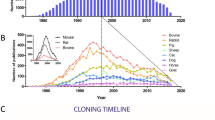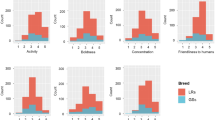Abstract
Since the first cloned dog “Snuppy” was born, many cloned dogs have been produced by somatic cell nuclear transfer (SCNT) technology. We reported the production of seven cloned drug detection dogs (named “Toppies”) in 2009. Although their genetic identity was confirmed, similarities in behavior and the drug-detecting ability were not examined. Therefore, this study is the first attempt to examine their behavior. We conducted the Campbell test which is commonly used to evaluate the tendency of dominance. Data were analyzed by the general linear mixed model. The scores among seven cloned puppies and four naturally-bred controls were significantly different (P < 0.0001). After the test, cloned and control puppies were trained according to the Korea Customs Detector Dog Training Center’s manual. The selection rate for detector dog in the cloned puppies was higher (86 %) than that of naturally-bred dogs (30 %). Therefore, it can be concluded that drug detection dogs with high performance can be propagated more efficiently using SCNT.




Similar content being viewed by others
References
Baguisi A, Behboodi E, Melican DT, Pollock JS, Destrempes MM, Cammuso C et al (1999) Production of goats by somatic cell nuclear transfer. Nat Biotechnol 17(5):456–461
Bartlett M (1979) A novice looks at puppy aptitude testing. Am Kennel Gazette. 1–14
Campbell WE (1972) A behavior test for puppy selection. Mod Vet Pract 12:29–33
Chesné P, Adenot PG, Viglietta C, Baratte M, Boulanger L, Renard J-P (2002) Cloned rabbits produced by nuclear transfer from adult somatic cells. Nat Biotechnol 20(4):366–369
Lee BC, Kim MK, Jang G, Oh HJ, Yuda F, Kim HJ et al (2005) Dogs cloned from adult somatic cells. Nature 436(7051):641
Lit L, Crawford CA (2006) Effects of training paradigms on search dog performance. Appl Anim Behav Sci 98(3–4):277–292
Maejima M, Inoue-Murayama M, Tonosaki K, Matsuura N, Kato S, Saito Y et al (2007) Traits and genotypes may predict the successful training of drug detection dogs. Appl Anim Behav Sci 107(3–4):287–298
Oh HJ, Hong SG, Park JE, Kang JT, Kim MJ, Kim MK et al (2009) Improved efficiency of canine nucleus transfer using roscovitine-treated canine fibroblasts. Theriogenology 72(4):461–470
Onishi A, Iwamoto M, Akita T, Mikawa S, Takeda K, Awata T et al (2000) Pig cloning by microinjection of fetal fibroblast nuclei. Science 289(5482):1188–1190
Palmour RM (1983) Genetic models for the study of aggressive behavior. Prog Neuropsychopharmacol Biol Psychiatry 7(4–6):513–517
Pérez-Guisado J, Lopez-Rodríguez R, Muñoz-Serrano A (2006) Heritability of dominant–aggressive behaviour in English Cocker Spaniels. Appl Anim Behav Sci 100(3–4):219–227
Pérez-Guisado J, Muñoz-Serrano A, López-Rodríguez R (2008) Evaluation of the Campbell test and the influence of age, sex, breed, and coat color on puppy behavioral responses. Can J Vet Res 72:269–277
Rooney NJ, Bradshaw JWS, Almey H (2004) Attributes of specialist search dogs—a questionnaire survey of UK dog handlers and trainers. J Forensic Sci 49(2):300–306
Savage AF, Maull J, Tian XC, Taneja M, Katz L, Darre M et al (2003) Behavioral observations of adolescent Holstein heifers cloned from adult somatic cells. Theriogenology 60(6):1097–1110
Slabbert JM, Odendaal JSJ (1999) Early prediction of adult police dog efficiency-a longitudinal study. Appl Anim Behav Sci 64:269–288
Wakayama T, Perry ACF, Zuccotti M, Johnson KR, Yanagimachi R (1998) Full-term development of mice from enucleated oocytes injected with cumulus cell nuclei. Nature 394(6691):369–374
Weiss E (2002) Selecting shelter dogs for service dog training. J Appl Anim Welf Sci 5(1):43–62
Weiss E, Greenberg G (1997) Service dog selection tests: effectiveness for dogs from animal shelters. Appl Anim Behav Sci 53:297–308
Williams M, Johnston JM (2002) Training and maintaining the performance of dogs (Canis familiaris) on an increasing number of odor discriminations in a controlled setting. Appl Anim Behav Sci 78:55–65
Acknowledgments
This study was supported by IPET (#311011-05-2-SB010), RDA (#PJ0089752013), RNL Bio (#550-20120006), Research Institute for Veterinary Science, the BK21 program and Cargill Agri Purina Korea. We thank Dr. Barry D. Bavister for his valuable editing of the manuscript.
Author information
Authors and Affiliations
Corresponding author
Additional information
Edited by Stephen Maxson.
Jin Choi and Ji Hyun Lee have contributed equally.
Rights and permissions
About this article
Cite this article
Choi, J., Lee, J.H., Oh, H.J. et al. Behavioral Analysis of Cloned Puppies Derived from an Elite Drug-Detection Dog. Behav Genet 44, 68–76 (2014). https://doi.org/10.1007/s10519-013-9620-z
Received:
Accepted:
Published:
Issue Date:
DOI: https://doi.org/10.1007/s10519-013-9620-z




